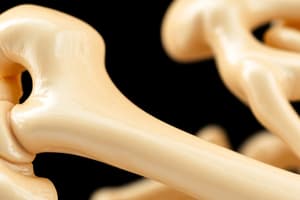Podcast
Questions and Answers
What are the functions of the skeletal system? (Select all that apply)
What are the functions of the skeletal system? (Select all that apply)
- Support and protection (correct)
- Movement (correct)
- Storage of minerals and energy reserve (correct)
- Hemopoiesis (correct)
What are the categories of bones according to shape? (Select all that apply)
What are the categories of bones according to shape? (Select all that apply)
- Flat bones (correct)
- Long bones (correct)
- Short bones (correct)
- Irregular bones (correct)
- Sutural bones (correct)
- Pneumatized bones (correct)
- Sesamoid bones (correct)
What are flat bones?
What are flat bones?
Strong and relatively light bones that provide protection for underlying soft tissue and a wide surface area for muscular attachment.
What are sutural bones?
What are sutural bones?
What are pneumatic bones?
What are pneumatic bones?
What characterizes long bones?
What characterizes long bones?
What defines irregular bones?
What defines irregular bones?
What are sesamoid bones?
What are sesamoid bones?
What are short bones?
What are short bones?
Intramembranous ossification is defined as _____
Intramembranous ossification is defined as _____
What types of bones are produced by dermal ossification?
What types of bones are produced by dermal ossification?
The steps of intramembranous ossification include 1) Ossification centers form within thickened regions of _____
The steps of intramembranous ossification include 1) Ossification centers form within thickened regions of _____
The steps of intramembranous ossification include 2) _____ undergoes calcification
The steps of intramembranous ossification include 2) _____ undergoes calcification
Match the following types of bone with their examples:
Match the following types of bone with their examples:
The anatomy of a long bone includes diaphysis, epiphysis, and _____
The anatomy of a long bone includes diaphysis, epiphysis, and _____
What are the steps of intracartilaginous ossification?
What are the steps of intracartilaginous ossification?
Study Notes
Functions of the Skeletal System
- Provides support and protection for the body’s organs.
- Facilitates movement by serving as attachment points for muscles.
- Responsible for hemopoiesis, the production of blood cells.
- Acts as a storage reservoir for minerals and energy reserves.
Categories of Bones by Shape
- Flat Bones: Include cranial bones, sternum, ribs, and scapula; provide protection and muscle attachment.
- Long Bones: Characterized by a long, slender shape; found in limbs; examples include humerus, femur, and tibia.
- Irregular Bones: Complex shapes with no uniform structure; ex: vertebrae.
- Pneumatized Bones: Contain air pockets; examples include the frontal and maxilla bones.
- Sutural Bones: Small, irregularly shaped found in sutures of the skull; also known as Wormian bones.
- Sesamoid Bones: Typically small and round; located near joints, particularly in the knees, hands, and feet.
- Short Bones: Cube-like shapes; provide strength and compactness; found in wrists and ankles.
Flat Bones
- Strong yet lightweight; offer considerable protection to vital organs.
- Provide a broad surface area that facilitates muscle attachments.
Sutural Bones
- Also called Wormian bones; small and uniquely shaped, typically situated along the skull’s suture lines.
Pneumatized Bones
- Hollow bones or those with numerous cavities; examples include the frontal bone and sphenoid.
Long Bones
- Comprised of three key parts: base, shaft, and head; crucial for mobility and support; located mainly in the extremities.
Irregular Bones
- Feature complex forms and surface structures that vary significantly; vertebrae serve as the primary example.
Sesamoid Bones
- Generally small and rounded, positioned within tendons near joints; assist in load distribution and joint movement.
Short Bones
- Characterized by a box or cube-like structure; designed for robust strength; commonly found in the wrist and ankle regions.
Intramembranous (Dermal) Ossification
- Process of bone growth occurring within a fibrous membrane; involves formation from mesenchymal tissue.
Dermal Ossification Derived Bones
- Flat bones of the skull, zygomatic bone, maxilla, mandible, and central part of the clavicle.
Steps of Intramembranous Ossification
- Ossification centers arise in thickened mesenchyme regions.
- Osteoid tissue undergoes calcification.
- Formation of woven bone and surrounding periosteum.
- Replacement of woven bone by lamellar bone leading to compact and spongy bone formation.
Endochondral Ossification
- Begins with a hyaline cartilage model; responsible for forming most bones, particularly in weight-bearing areas like limbs.
Steps of Intracartilaginous Ossification
- Development of a fetal hyaline cartilage model.
- Cartilage calcifies and forms a periosteal bone collar.
- Primary ossification center develops in the diaphysis.
- Secondary ossification centers appear in the epiphyses.
- Bone replaces cartilage except for articular cartilage and epiphyseal plates.
- Epiphyseal plates ossify into epiphyseal lines.
Anatomy of a Long Bone
- Diaphysis: The shaft or central part.
- Epiphysis: The end portions of the bone (head/base).
- Metaphysis: The region between diaphysis and epiphysis.
Examples of Bone Types
- Flat Bones: Include sternum, ribs, and scapula.
- Sutural Bones: Parietal, sphenoid, temporal, frontal, and occipital bones.
- Pneumatized Bones: Frontal, ethmoid, sphenoid, and maxilla bones.
- Long Bones: Humerus, radius, ulna, femur, tibia, and fibula.
- Irregular Bones: Vertebrae.
- Sesamoid Bones: Found inside tendons near knee, hands, and foot joints.
- Short Bones: Pisiform, triangular, capitate, talus, calcaneus, cuboid, and cuneiform bones.
Studying That Suits You
Use AI to generate personalized quizzes and flashcards to suit your learning preferences.
Description
Explore the functions of the skeletal system, including support, movement, and blood cell production. Additionally, learn about different categories of bones by shape such as flat, long, and irregular bones. Test your knowledge on the various types of bones and their roles in the body.




